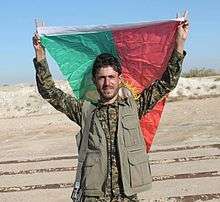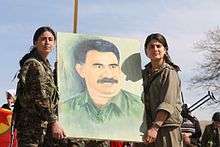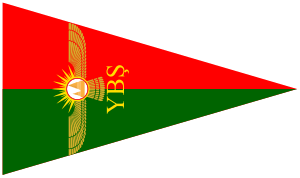Sinjar Resistance Units
| Sinjar Resistance Units | |
|---|---|
|
Yekîneyên Berxwedana Şengalê (YBŞ) Participant in Iraq War, Iraqi Civil War (2014–present) | |
|
Flag of YBŞ | |
| Active | 2007–present[1] |
| Ideology | Yazidi regionalism |
| Leaders |
Sheikh Khairy Khedr † Mazlum Shengal[2] |
| Headquarters | Sinjar, Nineveh Governorate, Iraq |
| Strength | 1,500[3] |
| Part of | Sinjar Alliance |
| Originated as | Malik Al-Tawus |
| Allies |
|
| Opponents |
|
| Battles and wars | |

The Sinjar Resistance Units (Kurdish: Yekîneyên Berxwedana Şengalê; YBŞ), formerly called King Peacock (Arabic: Malik Al-Tawus), is a non-political Yazidi militia formed in Iraq in 2007 to protect the Yazidi community in Iraq in the wake of attacks by Iraqi insurgents.[5] It is the second largest Yazidi militia, after the Protection Force of Sinjar (HPŞ).[6] However, it is much more active than the HPŞ in fighting against the Islamic State of Iraq and the Levant (ISIL).[6]
Together with its rather newly founded all-women offshoot, the Êzidxan Women's Units (YJÊ), and the formerly Peshmerga-aligned HPŞ, in October 2015 it founded the all-Yazidi joint commando umbrella structure Sinjar Alliance. YBŞ and YJÊ consider themselves under the umbrella of the Kurdistan Communities Union (KCK) and are operating in concert with Sunni Arab Shammar tribal militias and People's Defence Forces (HPG) of the Kurdistan Workers' Party (PKK).[7][6]
History

The Sinjar Resistance Units took part in the August 2014 Northern Iraq offensive, killing at least 22 ISIS fighters and destroying 5 armoured vehicles in the vicinity of the Sinjar Mountains.[1]
Hundreds of Yazidis received training from YPG instructors at the Serimli military base in Qamishli, Syria, before being sent back to the Mount Sinjar frontlines.[8] These forces were re-branded as the "Sinjar Resistance Units".[9][10]
Commander of Sinjar Resistance Units Sheikh Khairy Khedr was killed in action during the October 2014 clashes in Sinjar.[11]
There have been increased tensions between the YBS and the Kurdistan Regional Government (KRG). KRG forces largely fled Mount Sinjar when ISIS first attacked, leaving many Yazidis resentful and distrustful.[12]
In October 2015, the YBŞ participated in the foundation of the Sinjar Alliance as an all-Yazidi joint commando umbrella structure. Besides their all-women offshoot, the Êzidxan Women's Units (YJÊ), the formerly Peshmerga-aligned Protection Force of Sinjar (HPŞ)[2] and other, independent Yazidi units committed to the united Yazidi front.[13]
Under the joint command of the newly founded Sinjar Alliance, the Sinjar Resistance Units took part in the November 2015 Sinjar offensive.[14]
The Iraqi government allocated funds in its 2017 budget to provide an additional US$22 million, along with arms and supplies as a reward for its cooperation with the Shiite militia group Al-Hashd al-Shaabi (Popular Mobilization Forces).[15]
See also
References
- 1 2 "Yazidi militia claims to have killed at least 22 Islamic State militants". Haaretz. 22 August 2014. Retrieved 7 November 2014.
Malik al-Tawus is a self-defense group, believed to have been set up in 2007 to protect the Yazidi community in Iraq against attacks by radical Islamists.
- 1 2 "Yezidi forces form alliance against IS". Êzîdî Press. 31 October 2015. Retrieved 13 November 2015.
- ↑ "Yazidis Form Militia To Protect Sinjar Mountain". Aina. 6 August 2014. Retrieved 7 November 2014.
- ↑ ""Manbij operation will continue until ISIS is completely expelled"". ANF News. 15 August 2016. Retrieved 16 August 2016.
- ↑ Ridolfo, Kathleen (31 May 2007). "Christian population dwindling due to threats, attacks". Radio Free Europe / Radio Liberty. Retrieved 7 November 2014.
'We have formed a troop of the brave and faithful from the Yazidi clan called the Malik Al-Tawus [King Peacock] troop'
- 1 2 3 Paraszczuk, Joanna (11 June 2015). "Yazidi militias fight IS in Iraq, amid Kurdish rivalries". Radio Free Europe/Radio Liberty. Retrieved 26 October 2015.
- ↑ "On patrol with the Sinjar Resistance Units". Reuters. Retrieved 1 December 2016.
- ↑ "Kurdish militants train hundreds of Yazidis to fight Islamic State". Aina. 17 August 2014. Retrieved 7 November 2014.
- ↑ Khalel, Sheren; Vickery, Matthew (23 February 2015). "Yazidis battle ISIL: Disaster 'made us stronger'". Al Jazeera English.
- ↑ "IS-Terror in Shingal: Wer kämpft gegen wen? Ein Überblick". Êzidî Press. 12 October 2014. Retrieved 17 November 2014.
- ↑ "Iraqi journalists flee as ISIS closes in". 24 October 2014. Retrieved 7 November 2014.
- ↑ Krohn, Jonathan; Spencer, Richard. "Yazidi leader 'arrested by Kurdish authorities'". The Telegraph. Retrieved 16 August 2015.
- ↑ "Independent Yezidi units join Shingal alliance". Êzîdî Press. 31 October 2015. Retrieved 13 November 2015.
- ↑ "Shingal: KurdInnen starten mit vereinten Kräften Großoffensive gegen IS". Kurdische Nachrichten (in German). 12 November 2015. Retrieved 13 November 2015.
- ↑ "Iraqi gov't provides funds for PKK terrorists in its 2017 budget". Daily Sabah. 30 November 2016. Retrieved 30 November 2016.
[[Category:Anti-ISIL factions in Iraq] ]
